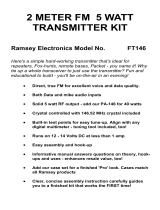
Notes
4
Educational Electronics Kits are intended for educational and demonstration purposes only. They are not intended for use in
commercial applications. If they are used in such applications the purchaser assumes all responsibility for ensuring compliance
with all local laws. In addition, they cannot be used as a part of life support systems, or systems that for use as or as a part of life
support systems, or systems that might create a hazardous situation of any kind.
!
Thank you for purchasing AVT product. Please take your time to read carefully the important information below concering use of this
product.
• If the kit is used to switch currents greater than 24V it is necessary to have the installation and performed by a trained professional
authorized for such work. The kit may only be used in such application if it was installed in a safe to touch enclosure.
• Never exceed the limits or ratings listed in the 'Specifications' section at the this user guide.
Failures in modern electronic component are very rare as 95% of non-working kits are due to poor soldering or components placed in
the wrong location or orientation so please check your work carefully.
• Battery or wall-adaptor are safe devices. They do not require special attention unless main voltage is connected to an output e.g. a
relay.
• If the kit is used in schools or educational facilities or similar institutions the operation must be supervised by trained and authorized
staff.
• The product itself and all parts thereof (including packing material) are not suitable toys for childern! (choking hazard, risk of electric
shock, ...)
AVT SPV reserves the right to make changes without prior notice.
Assembly and connection of the device not in accordance with the instructions, unauthorized modification of components and any structural modifications may cause damage to the device and
endanger the person using it. In this case, the manufacturer and its authorized representatives shall not be liable for any damages arising directly or indirectly from the use or malfunction of the
product.
This symbol means do not dispose of your
product with your other household waste.
Instead, you should protect human health
and the environment by handing over your
waste equipment to a designated collection
point for the recycling of waste electrical
and electronic equipment.
Leszczynowa 11 Street,
03-197 Warsaw, Poland
http://avtkits.com/
AVT SPV Sp. z o.o.






